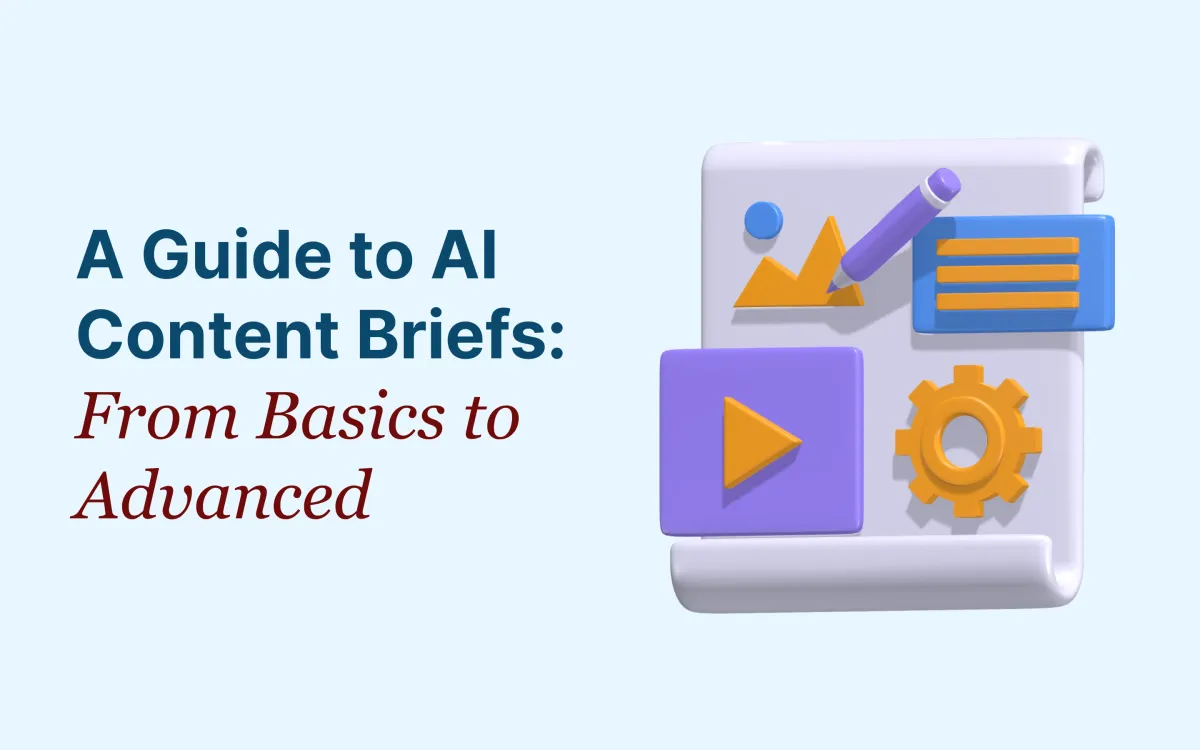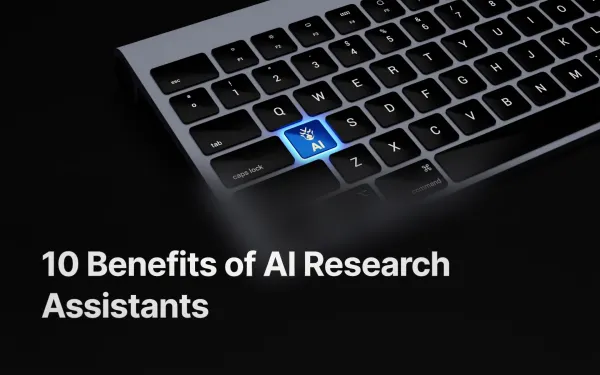A Guide to AI Content Briefs: From Basics to Advanced
Discover how to create effective AI content briefs with our comprehensive guide. Learn the basics, explore advanced techniques, and enhance your content strategy using AI.

How is AI Content Brief Helping the Way We Create Content?
In today's digital world, content creation is evolving at an unprecedented rate, thanks to the transformative power of Artificial Intelligence (AI).
From generating engaging articles to optimizing content for SEO, AI is becoming an important tool for marketers, writers, and businesses alike. But what are the key concepts driving this revolution?
To use the full potential of AI in content creation, it’s important to understand the underlying technologies and methodologies that make it all possible.
In this article, we'll explore the most important AI concepts you need to know to stay ahead in the content creation game.
Definition of an AI Content Brief
An AI Content Brief is a document generator tool that outlines how to use artificial intelligence tools and concepts to create, enhance, and optimize content.
An AI Content Brief guides content creators in using AI technologies like machine learning and natural language processing to produce high-quality, relevant content efficiently.
Key Concepts in AI for Content Creation

1. Machine Learning (ML)
Machine Learning is a type of AI that allows computers to learn from data and improve their performance over time without being explicitly programmed.
Think of it as teaching a computer to recognize patterns in data—like how a child learns to identify objects by seeing examples. In content creation, Machine Learning can help automate tasks such as content curation, recommendation systems, and even predicting what type of content will resonate with your audience.
2. Neural Networks
Neural Networks are a set of algorithms designed to recognize patterns, much like the human brain does. They are composed of layers of interconnected "neurons" that process and transmit information.
In content creation, neural networks can be used to analyze large amounts of text, images, or videos, enabling tools that can generate content, edit images, or even suggest improvements to your writing.
3. Natural Language Processing (NLP)
Natural Language Processing is a branch of AI focused on the interaction between computers and human language. It's what allows machines to understand, interpret, and respond to text or spoken language.
For content creators, Natural Language Processing is the technology behind tools that can generate blog posts, translate languages, summarize articles, or even detect the sentiment in customer reviews.
4. Deep Learning
Deep Learning is a subset of Machine Learning that uses complex neural networks with many layers (hence "deep") to model and understand intricate patterns in data.
This is the technology behind more advanced AI applications, like voice recognition and image processing. In content creation, deep learning can help in generating realistic text, creating art, or even producing videos that are almost indistinguishable from human-made content.
5. Computer Vision
Computer Vision is the field of AI that enables machines to see and interpret the visual world, just like humans do. It involves teaching computers to recognize and analyze images and videos. In the realm of content creation, computer vision can be used for tasks like automatically tagging images, generating captions, or even creating entirely new visuals based on the content you're working with.
These AI concepts are the building blocks of the technologies that are revolutionizing content creation. By understanding them, you can better appreciate how AI is transforming the way we produce and consume content and how you can leverage these tools to enhance your work.
Advanced AI Techniques of AI Content Brief

1. Generative Adversarial Networks (GANs)
Generative Adversarial Networks, or GANs, are a fascinating AI technique where two neural networks work together to create new, realistic data. One network generates data (like images or text), while the other tries to determine whether the data is real or fake.
Over time, the generator gets better at creating realistic data, while the discriminator gets better at spotting fakes. In content creation, Generative Adversarial Networks can be used to create incredibly lifelike images, generate realistic video content, or even compose music. It's like having an AI that can create art, design, or media that is almost indistinguishable from what a human would make.
2. Transfer Learning
Transfer Learning is an approach in AI where a model developed for one task is reused as the starting point for a model on a second task. It's like when you learn to play one musical instrument, and that knowledge makes it easier to learn another instrument.
In AI, this means you can take a model trained on a large dataset (like images or text) and apply it to a new, smaller dataset with less training time and data. For content creators, transfer learning can be a powerful tool, enabling the creation of custom content with less data and effort, such as fine-tuning an AI model to generate articles specific to your niche.
3. Reinforcement Learning
Reinforcement Learning is a type of AI where an agent learns to make decisions by performing actions and receiving feedback in the form of rewards or penalties. It’s like training a pet: when the pet does something good, you reward it, and when it does something bad, you discourage it.
Over time, the pet (or the AI) learns to make better decisions. In content creation, reinforcement learning can be used to optimize content strategies, like choosing the best time to post on social media, or fine-tuning recommendation systems that suggest the most engaging content to users.
4. Supervised vs. Unsupervised Learning
Supervised Learning and Unsupervised Learning are two fundamental types of machine learning.
In Supervised Learning, the AI is trained on a labeled dataset, meaning that each input comes with the correct output. It's like learning with a teacher who provides the right answers. This approach is often used for tasks like predicting the success of content based on past data or categorizing content by type.
On the other hand, Unsupervised Learning involves training the AI on data that is not labeled, so it has to find patterns and relationships on its own. It's like exploring a new subject without a guide—you're figuring out the rules as you go. Unsupervised learning is useful for discovering new trends or grouping similar pieces of content together without prior knowledge of the categories.
AI Applications in Industry-Specific Content

1. AI in Healthcare
Artificial intelligence is revolutionizing the healthcare industry by making processes more efficient, accurate, and personalized. For example, AI can analyze medical images, like X-rays or MRIs, to detect diseases such as cancer much earlier than traditional methods.
Artificial intelligence-powered chatbots can assist patients by answering their questions, scheduling appointments, and even reminding them to take their medications. Imagine a healthcare content creator using Artificial intelligence to generate personalized health tips based on a patient's medical history, creating more relevant and impactful content that improves patient care.
Example: A hospital uses AI to scan patient records and automatically generate personalized care plans. These plans can include diet suggestions, exercise routines, and medication reminders, all tailored to the individual’s health condition.
2. AI in Finance
In finance, Artificial intelligence is being used to predict market trends, detect fraudulent activities, and personalize customer experiences. For instance, AI can analyze massive amounts of financial data to predict stock prices or detect unusual patterns in transactions that could indicate fraud.
Banks use Artificial intelligence to provide personalized financial advice to customers, helping them manage their investments and savings more effectively. For financial content creators, AI can help generate detailed reports, forecast trends, or even create personalized financial advice columns based on a user’s spending habits.
Example: A financial advisory firm uses AI to analyze a client’s spending and saving patterns, automatically generating a personalized investment strategy that can be sent as a monthly report.
3. AI in Marketing Automation
Artificial intelligence is a powerful tool in marketing automation, helping businesses streamline their marketing efforts and connect with customers more effectively. Artificial intelligence can automate tasks like email campaigns, social media posting, and lead nurturing, ensuring that the right content reaches the right audience at the right time.
Artificial intelligence can also analyze customer data to create personalized marketing messages, improving engagement and conversion rates. For marketers, this means more time to focus on strategy while AI handles the execution.
Example: An e-commerce company uses AI to automatically segment its customers based on their browsing and purchase history. The AI then generates personalized email campaigns with product recommendations tailored to each customer’s interests, increasing the chances of a sale.
4. AI for Data Analytics
AI for Data Analytics involves using AI to process and analyze large datasets, uncovering insights that would be difficult or impossible for humans to find on their own. AI can identify trends, predict outcomes, and even suggest actions based on the data it analyzes.
This is especially useful in industries like retail, where understanding customer behavior is key to success. AI can analyze sales data to identify which products are most popular, forecast future demand, and even optimize pricing strategies.
Example: A retail chain uses AI to analyze customer purchase data across all its stores. The AI identifies that certain products sell better in specific regions and suggests adjusting inventory and pricing to match local preferences, leading to increased sales and reduced waste.
Emerging Trends in Artificial Intelligence

1. Edge AI
Edge AI refers to the deployment of AI algorithms directly on devices like smartphones, cameras, or IoT gadgets, rather than relying on cloud-based servers. This allows for faster processing, as data doesn't need to travel back and forth to the cloud, and enhances privacy since data stays on the device.
In industries like manufacturing, Edge AI can be used to monitor equipment in real-time, predicting failures before they happen and avoiding costly downtime.
Example: A smart home security system uses Edge AI to process video footage locally, detecting and alerting the homeowner about any unusual activity in real-time, even if the internet connection is down.
2. AI and IoT Integration
The integration of AI with the Internet of Things (IoT) is creating smarter, more responsive systems. IoT devices are gadgets connected to the internet, like smart thermostats or wearable fitness trackers.
When combined with AI, these devices can analyze data and make intelligent decisions on their own. In healthcare, AI and IoT integration can be used to monitor a patient’s vital signs continuously, alerting doctors immediately if there’s a problem.
Example: A smart factory uses IoT sensors on all its machines, with AI analyzing the data in real-time. If a machine starts to overheat or malfunction, the AI immediately triggers a shutdown and alerts maintenance, preventing damage and ensuring safety.
3. Quantum AI
Quantum AI is an emerging field that combines quantum computing with artificial intelligence. Quantum computers can process vast amounts of data simultaneously, solving complex problems much faster than traditional computers.
While still in its early stages, Quantum AI has the potential to revolutionize fields like drug discovery, financial modeling, and cryptography. Imagine being able to simulate every possible interaction between molecules to find a cure for diseases, or creating ultra-secure encryption methods that are impossible to break.
Example: A pharmaceutical company uses Quantum AI to simulate millions of chemical reactions in seconds, rapidly identifying potential new drugs that could take years to discover using conventional methods.
4. AI in Cybersecurity
Artificial intelligence is becoming an important tool in cybersecurity, helping to protect data and systems from increasingly sophisticated cyber threats.
Artificial intelligence can monitor network traffic, detect unusual patterns that may indicate a cyberattack, and respond in real-time to prevent breaches. It can also learn from past incidents to improve its defenses continuously. For businesses, this means stronger protection of sensitive data and a reduced risk of costly security breaches.
Example: A financial institution uses AI to monitor all transactions across its network. The AI detects an unusual pattern in account access attempts and automatically locks the compromised accounts, preventing a large-scale cyberattack from stealing customer data.
5. Autonomous Systems
Autonomous systems are AI-powered machines that can perform tasks without human intervention. This includes self-driving cars, drones, and robots that can operate in warehouses, hospitals, or even on farms.
Autonomous systems use AI to navigate, make decisions, and adapt to their environments. For instance, a self-driving car uses AI to detect and avoid obstacles, follow traffic rules, and choose the best route to reach its destination safely. In agriculture, autonomous drones can monitor crops and apply pesticides only where needed, increasing efficiency and reducing environmental impact.
Example: A logistics company uses autonomous robots in its warehouses to pick and pack items for shipping. The AI-powered robots navigate the warehouse floor, avoid obstacles, and optimize their paths to speed up order fulfillment, reducing the time it takes to process orders.
These emerging trends in AI are shaping the future, bringing more intelligence, efficiency, and autonomy to various aspects of our lives. As these technologies continue to evolve, they will open up new possibilities and challenges, making it essential to stay informed and adaptable.
Conclusion
AI Content Briefs are rapidly changing the world around us, bringing new opportunities and innovations across various industries. From making healthcare more personalized to protecting our data with advanced cybersecurity, AI is becoming an essential part of our daily lives.
As these technologies continue to develop, staying informed about emerging trends like Edge AI, AI and IoT integration, and Quantum AI will be crucial for anyone looking to stay ahead in their field.
Whether you’re a business owner, content creator, or just someone interested in technology, understanding these AI concepts can help you make smarter decisions and take advantage of the benefits AI has to offer.
The future of AI is full of possibilities, and by keeping up with these trends, you can be part of the exciting changes ahead.
Frequently Asked Questions
1. What is an AI content brief, and how does it differ from a traditional content brief?
An AI content brief outlines the key AI concepts and technologies relevant to creating content, providing guidance on how to leverage AI tools. Unlike traditional briefs, it focuses on integrating AI to enhance content creation processes.
2. How can AI help improve the quality of content creation?
AI can analyze vast amounts of data, automate repetitive tasks, and generate personalized content, leading to higher-quality, more relevant, and engaging content for your audience.
3. What are some essential AI concepts every content creator should know?
Key AI concepts include Machine Learning, Natural Language Processing (NLP), Deep Learning, Neural Networks, and Computer Vision. Understanding these can help you better utilize AI in your content strategies.
4. How can AI tools be used to create personalized content?
AI tools can analyze user behavior and preferences to generate personalized content recommendations, tailor messages, and even create customized articles or visuals that resonate with individual users.
5. Are there ethical concerns when using AI in content creation?
Yes, ethical concerns include issues like AI bias, the need for transparency in AI decision-making, and ensuring that AI-generated content is fair and accurate. Understanding AI ethics is crucial to responsibly using AI in content creation.



